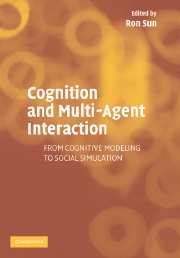Book contents
- Frontmatter
- Contents
- List of Contributors
- Preface
- PART 1 INTRODUCTION
- PART 2 OVERVIEWS OF COGNITIVE ARCHITECTURES
- PART 3 MODELING AND SIMULATING COGNITIVE AND SOCIAL PROCESSES
- 5 Cognitive Architectures, Game Playing, And Human Evolution
- 6 Simulating A Simple Case Of Organizational Decision Making
- 7 Cognitive Modeling of Social Behaviors
- 8 Cognitive Agents Interacting in Real and Virtual Worlds
- 9 Modeling Social Emotions and Social Attributions
- 10 Communicating and Collaborating with Robotic Agents
- 11 Behavior-Based Methods for Modeling and Structuring Control of Social Robots
- 12 Evolution of a Teamwork Model
- 13 Sociality in Embodied Neural Agents
- 14 Cognitive Architecture and Contents for Social Structures and Interactions
- PART 4 A SYMPOSIUM
- Index
14 - Cognitive Architecture and Contents for Social Structures and Interactions
Published online by Cambridge University Press: 15 December 2009
- Frontmatter
- Contents
- List of Contributors
- Preface
- PART 1 INTRODUCTION
- PART 2 OVERVIEWS OF COGNITIVE ARCHITECTURES
- PART 3 MODELING AND SIMULATING COGNITIVE AND SOCIAL PROCESSES
- 5 Cognitive Architectures, Game Playing, And Human Evolution
- 6 Simulating A Simple Case Of Organizational Decision Making
- 7 Cognitive Modeling of Social Behaviors
- 8 Cognitive Agents Interacting in Real and Virtual Worlds
- 9 Modeling Social Emotions and Social Attributions
- 10 Communicating and Collaborating with Robotic Agents
- 11 Behavior-Based Methods for Modeling and Structuring Control of Social Robots
- 12 Evolution of a Teamwork Model
- 13 Sociality in Embodied Neural Agents
- 14 Cognitive Architecture and Contents for Social Structures and Interactions
- PART 4 A SYMPOSIUM
- Index
Summary
INTRODUCTION
The aim of this chapter is to answer some of the crucial questions of this book from a specific position: that of a group of theoretical psychologists and social scientists working within the domain of Artificial Intelligence, “Agents” and Multi-Agent Systems, and Social Simulation. The crucial questions
What is needed in an agent's architecture designed for MAS, social theory, and a non-reductive social simulation (Sun, 2001)? What is required at the individual cognition level to produce collective behavior, the emergent order; to perform the social roles; to build institutions; to play functions? Which are the peculiar features of Social Structures as they emerge among cognitive agents? Which mental representations supporting or implementing cooperation, groups, norms, institutions, roles, etc. are needed? Is methodological individualism (plus cognitive representations) sufficient for social theory? Are social phenomena (collectively) intended by the agents? Or how are they related to the agents' understanding and intending?
In this chapter it is argued (although in a synthetic way and necessarily pointing to specific work) that
Social and cultural phenomena cannot be deeply accounted for without explaining how they work through the individual agents' minds (mental “counterparts” or “mediators”);
This requires a richer cognitive model (architecture) for “Agents,” moving fromformal and computational AI and ALife models, closer to those developed in psychology, cognitive science (see several chapters in this book), and in cognitive approaches in economics, sociology, and organization studies.
However, the “individualistic + cognitive” approach is not sufficient for the social theory (even when modeling joint and collective attitudes and actions). The social actors do not understand, negotiate, and plan for all their collective activities and results.
- Type
- Chapter
- Information
- Cognition and Multi-Agent InteractionFrom Cognitive Modeling to Social Simulation, pp. 355 - 390Publisher: Cambridge University PressPrint publication year: 2005
- 2
- Cited by

